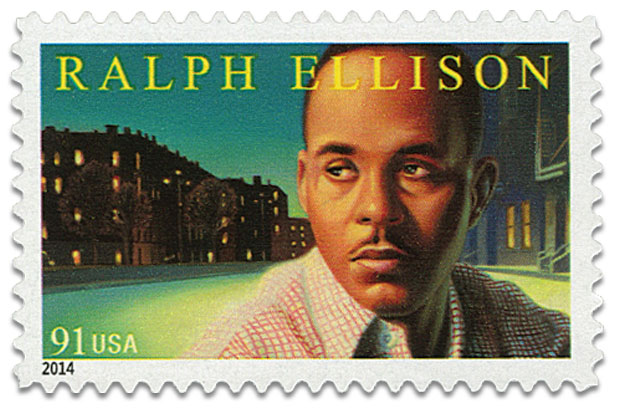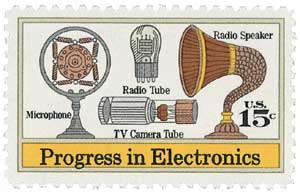
# 4866a PB - 2014 91c Imperf Ralph Ellison
U.S. # 4866a
2014 91¢ Ralph Ellison Imperforate
Â
Ralph Waldo Ellison was born on March 1, 1913, in Oklahoma City, Oklahoma. A self-proclaimed Renaissance Man, Ellison was a talented musician and writer, most famous for his novel, Invisible Man. Ellison was named by his book-loving father for poet Ralph Waldo Emerson. In fact, in later years, Ellison learned that his father, who died in 1916, hoped Ralph would grow up to become a poet. Young Ralph inherited a lifelong fondness for literature. While still young, Ellison was a self-proclaimed Renaissance man. His wide-ranging interests included music, sculpting, constructing audio equipment, and writing. He got free music lessons on the trumpet and saxophone and was his school’s bandmaster. Ellison also helped support his family working as a busboy, shoeshine boy, hotel waiter, and dental assistant. Ellison applied to the prestigious Tuskegee Institute twice, and was finally admitted in 1933 because the school orchestra needed a trumpet player. Ellison was disappointed in how class-conscious the school was and felt like an outsider. However, he enjoyed spending his free time in the library, where he eventually worked as a desk clerk. He read the works of James Joyce and Gertrude Stein and said that T.S. Eliot’s The Waste Land was a major inspiration. Ellison was also largely influenced by his English teacher Morteza Drezel Sprague, who helped him see “the possibilities of literature as a living art.†In 1936, Ellison moved to New York City to study sculpture. He quickly met Langston Hughes, Romare Bearden, and Richard Wright. After working for the Federal Writers Project and submitting book reviews, Ellison was encouraged to pursue a career as an author. Along with Wright, he became associated with Communist Party, but left it during World War II. He then began writing his most famous novel, Invisible Man, as a response to what he saw as the party leadership’s betrayal of African Americans. Published in 1952, Invisible Man dealt with issues of racial prejudice and the search for personal identity. A new type of black character was introduced, a man who was educated and well spoken. In the book, the narrator calls himself invisible because “people refuse to see†him.  Invisible Man won the National Book Award in 1953. In his acceptance speech, he said he felt he had made “an attempt at a major novel†and was unsatisfied with the book.  Invisible Man was Ellison’s only novel published during his lifetime and the mark left by it continues to be felt in literature and throughout American culture. Ellison went on to write many significant essays, which he collected in Shadow and Act in 1964. He also taught at Bard College, Rutgers University, and Yale University. Ellison spent a considerable amount of time working on another novel, writing over 2,000 pages. More than 300 pages of it were destroyed in a 1967 fire and he never finished it during his lifetime. He died from pancreatic cancer on April 16, 1994. His second novel, Juneteenth, was published posthumously in 1999. During his career, Ellison was admitted to the American Academy of Arts and Letters, received two President’s Medals and a State Medal from France. He also received the Langston Hughes Medal and the National Medal of Arts.  The New York Times once proclaimed him “among the gods of America’s literary Parnassus.â€Birth of Ralph Ellison







Â
91¢ Ralph Ellison, issued to satisfy the first-class rate for mail weighing up to three ounces
Issue Date: February 18, 2014
City: Kansas City, MO
Category: Commemorative
Printed By: CCL Label, Inc.
Printing Method: Photogravure in sheets of 200, with 10 panes of 20 per sheet
Perforations: Imperforate
Self-adhesive
Â
This stamp is the 29th in the Literary Arts Series. It covered the 3-ounce domestic letter rate that became effective Jan. 26, 2014. The stamp pictures author Ralph Ellison in front of a Harlem street scene at twilight
Â
Scarce Modern Imperforates
The modern imperforate stamps are one of the hottest stories around. In 2012, the U.S. Postal Service released some issues as press sheets. The sheets with die cut perforations were issued in limited quantities.Â
Â
To the surprise of many collectors, officials then issued a small number of press sheets without perforations. The uncut sheets were only available in Kansas City, Missouri, yet most sold out immediately. In an instant, the imperforate stamp sheets became modern rarities. For example, only 75,000 Baseball All-Star se-tenant sheets were issued compared to 118,000 Bugs Bunny sheets with the 10th stamp imperforate.
Â
In a controversial move, the editors of Scott Catalogue announced they would not list or give numbers to these stamps because they did not fit Scott guidelines. This decision was strongly debated since the imperforate stamps are valid for postage. They eventually decided to give the stamps minor numbers and have continued issuing imperforates in the years since.
Â
Because they were issued in such limited quantities, these scarce modern imperforates can be difficult to find. Luckily Mystic purchased a small number of each imperforate stamp issued so you can add these modern rarities to your collection. Be one of the lucky few – order today.Â
Â
U.S. # 4866a
2014 91¢ Ralph Ellison Imperforate
Â
Ralph Waldo Ellison was born on March 1, 1913, in Oklahoma City, Oklahoma. A self-proclaimed Renaissance Man, Ellison was a talented musician and writer, most famous for his novel, Invisible Man. Ellison was named by his book-loving father for poet Ralph Waldo Emerson. In fact, in later years, Ellison learned that his father, who died in 1916, hoped Ralph would grow up to become a poet. Young Ralph inherited a lifelong fondness for literature. While still young, Ellison was a self-proclaimed Renaissance man. His wide-ranging interests included music, sculpting, constructing audio equipment, and writing. He got free music lessons on the trumpet and saxophone and was his school’s bandmaster. Ellison also helped support his family working as a busboy, shoeshine boy, hotel waiter, and dental assistant. Ellison applied to the prestigious Tuskegee Institute twice, and was finally admitted in 1933 because the school orchestra needed a trumpet player. Ellison was disappointed in how class-conscious the school was and felt like an outsider. However, he enjoyed spending his free time in the library, where he eventually worked as a desk clerk. He read the works of James Joyce and Gertrude Stein and said that T.S. Eliot’s The Waste Land was a major inspiration. Ellison was also largely influenced by his English teacher Morteza Drezel Sprague, who helped him see “the possibilities of literature as a living art.†In 1936, Ellison moved to New York City to study sculpture. He quickly met Langston Hughes, Romare Bearden, and Richard Wright. After working for the Federal Writers Project and submitting book reviews, Ellison was encouraged to pursue a career as an author. Along with Wright, he became associated with Communist Party, but left it during World War II. He then began writing his most famous novel, Invisible Man, as a response to what he saw as the party leadership’s betrayal of African Americans. Published in 1952, Invisible Man dealt with issues of racial prejudice and the search for personal identity. A new type of black character was introduced, a man who was educated and well spoken. In the book, the narrator calls himself invisible because “people refuse to see†him.  Invisible Man won the National Book Award in 1953. In his acceptance speech, he said he felt he had made “an attempt at a major novel†and was unsatisfied with the book.  Invisible Man was Ellison’s only novel published during his lifetime and the mark left by it continues to be felt in literature and throughout American culture. Ellison went on to write many significant essays, which he collected in Shadow and Act in 1964. He also taught at Bard College, Rutgers University, and Yale University. Ellison spent a considerable amount of time working on another novel, writing over 2,000 pages. More than 300 pages of it were destroyed in a 1967 fire and he never finished it during his lifetime. He died from pancreatic cancer on April 16, 1994. His second novel, Juneteenth, was published posthumously in 1999. During his career, Ellison was admitted to the American Academy of Arts and Letters, received two President’s Medals and a State Medal from France. He also received the Langston Hughes Medal and the National Medal of Arts.  The New York Times once proclaimed him “among the gods of America’s literary Parnassus.â€Birth of Ralph Ellison







Â
91¢ Ralph Ellison, issued to satisfy the first-class rate for mail weighing up to three ounces
Issue Date: February 18, 2014
City: Kansas City, MO
Category: Commemorative
Printed By: CCL Label, Inc.
Printing Method: Photogravure in sheets of 200, with 10 panes of 20 per sheet
Perforations: Imperforate
Self-adhesive
Â
This stamp is the 29th in the Literary Arts Series. It covered the 3-ounce domestic letter rate that became effective Jan. 26, 2014. The stamp pictures author Ralph Ellison in front of a Harlem street scene at twilight
Â
Scarce Modern Imperforates
The modern imperforate stamps are one of the hottest stories around. In 2012, the U.S. Postal Service released some issues as press sheets. The sheets with die cut perforations were issued in limited quantities.Â
Â
To the surprise of many collectors, officials then issued a small number of press sheets without perforations. The uncut sheets were only available in Kansas City, Missouri, yet most sold out immediately. In an instant, the imperforate stamp sheets became modern rarities. For example, only 75,000 Baseball All-Star se-tenant sheets were issued compared to 118,000 Bugs Bunny sheets with the 10th stamp imperforate.
Â
In a controversial move, the editors of Scott Catalogue announced they would not list or give numbers to these stamps because they did not fit Scott guidelines. This decision was strongly debated since the imperforate stamps are valid for postage. They eventually decided to give the stamps minor numbers and have continued issuing imperforates in the years since.
Â
Because they were issued in such limited quantities, these scarce modern imperforates can be difficult to find. Luckily Mystic purchased a small number of each imperforate stamp issued so you can add these modern rarities to your collection. Be one of the lucky few – order today.Â
Â











